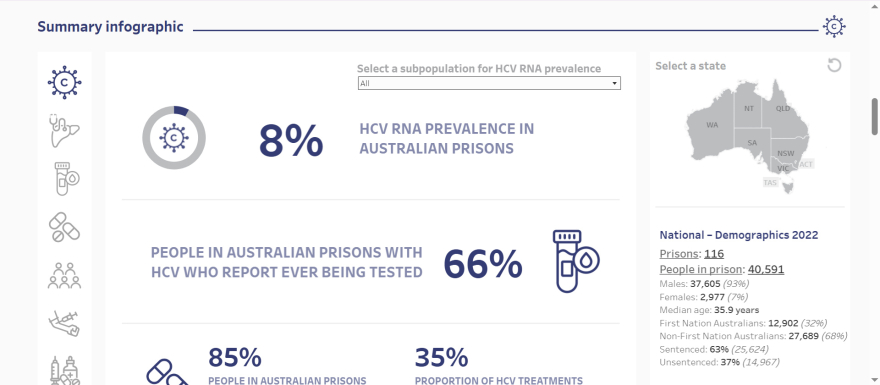Despite Australia making significant progress towards eliminating hepatitis C, the disease continues to pose a serious public health threat in Australia. There are an estimated 70,000 people still living with chronic infection, and several thousand new cases are diagnosed each year.
Prisons play a pivotal role in hepatitis C elimination efforts, as there are strong links between injecting drug use, incarceration and infection risk, with estimated prevalence of chronic hepatitis C at 8 per cent. Because of this, people in prison and prison settings are a priority population for focused hepatitis C elimination efforts.
The population of people in prison are often marginalised, and generally have limited contact with mainstream health services in the community. As such, imprisonment can offer a unique opportunity for providing health care that may otherwise be missed. However, delivering health services in prisons comes with its own set of challenges. These include frequent transfers and releases, overcrowding, high levels of mental and chronic illness, and competing health and security priorities.
In 2017, in response to these challenges, the National Prisons Hepatitis Network (NPHN) was created, which is administered by the Kirby Institute at UNSW Sydney, the Burnet Institute and St Vincent’s Hospital Melbourne. With more than 250 current members, the network is made up of academics, clinicians, healthcare administrators and advocates. It aims to support Australia’s goal to eliminate hepatitis C as a public health threat by 2030 by coordinating a national approach to prison-based elimination.
The NPHN Surveillance Dashboard: A critical resource
Surveillance data allows researchers to understand the burden of disease and engagement with health services, and ultimately track progress towards national and prison-based elimination of hepatitis C. For this reason, it's crucial to make surveillance data available – in an easy-to-digest way – to the public and people working in the sector.
Co-designed with key stakeholders from the custodial sector, the NPHN Surveillance Dashboard is an interactive, web-based tool which displays prison-based blood-borne virus (BBV) surveillance data collected from various sources, including the AusHep study, Australian Prisons Pharmacy Surveillance Project and regularly collected service data from the NPHN.
As well as portraying national and jurisdiction information, the Dashboard illustrates information for sub-populations such as men and women on prevalence, testing, treatment and opioid agonist therapy uptake. The Dashboard also describes injecting drug behaviours and health service characteristics, and enables comparisons between states and territories, helping to identify disparities and guide more effective, evidence-based healthcare responses.
Key data shows need for enhanced testing, treatment and prevention efforts
Statistics from the dashboard show that, in 2022 alone, more than a third of all hepatitis C treatments in Australia – 35 per cent – were initiated in prison settings. This is despite people in prison making up only a small fraction of the national population, demonstrating the significant and growing contribution of the prison sector to national elimination efforts.
The data also shows that while testing and treatment rates among people in prison are high (87% and 85% respectively), there is wide variability across states and territories, indicating a need for continued focused efforts to enhance testing and treatment uptake in all prisons. Further, sharing of injecting equipment which poses the highest risk of transmission is very common in prison (92% of those who reported recent injecting drug use in prison also reported sharing), highlighting the urgent need for improved access to prevention and harm reduction measures in the prison.
“The dashboard provides a much-needed lens into one of the most under-served parts of the healthcare system,” says Dr Yumi Sheehan, Senior Research Fellow at the Kirby Institute and NPHN Coordinator, who was a project lead in the development of the Dashboard. “Not only will it act as an invaluable resource for those working in correctional health, but it will also be essential for empowering services, researchers and decision-makers to track progress, close gaps and improve lives.”
The NPHN Surveillance Dashboard is funded through strategic research funding provided by the Commonwealth Department of Health and Ageing to the Kirby Institute.
Access the dashboard here.

